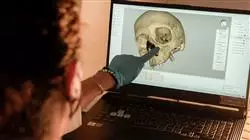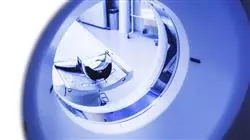University certificate
Scientific endorser

The world's largest faculty of nursing”
Introduction to the Program
You will specifically detail visual findings on the physical condition of the victims and will contribute to the specialists' ability to determine the causes of their deterioration after completing this 100% online Professional master’s degree”

Technological advances are completely transforming the field of Forensic Radiology, making it possible to obtain accurate images that serve to identify and record injuries or diseases in the bodies of deceased persons. As a result, nursing professionals must be prepared to actively collaborate with medical personnel and other authorities to determine the cause of death or injury. In particular, they need to be up to date on advances in imaging techniques and tools that make it possible to recognize victims and even reconstruct crime scenes. However, to perform their work with maximum efficiency, these professionals need to constantly acquire new skills for the analysis of the results obtained.
In this context, TECH implements a program in Forensic Radiology for Nursing. Developed by references in this field, the syllabus will provide graduates with the latest techniques in Diagnostic Imaging. Therefore, graduates will acquire practical skills to handle state-of-the-art machinery such as X-rays, MRI and CT scans. In this way, they will be able to capture detailed images of the deceased to analyze fractures, foreign objects or other relevant evidence for forensic investigations. The syllabus will also delve into Bone Physiopathology in order to correctly interpret the characteristics of traumatic injuries, determining both their nature and possible mechanism of injury. Additionally, the materials will investigate casuistry such as wounds caused by sharp elements and firearms.
On the other hand, the university program is based on the effective Relearninglearning method. Thanks to this, students will reduce the hours of study and will solidly consolidate the concepts addressed during this academic itinerary. Moreover, since it is taught 100% online, the only thing students will need is a device with Internet access to view the academic content hosted on the virtual platform. Undoubtedly, an ideal opportunity to reconcile daily activities with a high quality educational experience.
A highly skilled university program created to boost your career as a nurse and place you at the forefront of competitiveness in the Forensic Radiology industry"
This Professional master’s degree in Forensic Radiology for Nursing contains the most complete and up-to-date scientific program on the market. The most important features include:
- The development of practical cases presented by experts in Forensic Radiology
- The graphic, schematic and eminently practical contents with which it is conceived gather scientific and practical information on those disciplines that are indispensable for professional practice
- Practical exercises where self-assessment can be used to improve learning
- Its special emphasis on innovative methodologies
- Theoretical lessons, questions to the expert, debate forums on controversial topics, and individual reflection assignments
- Content that is accessible from any fixed or portable device with an Internet connection
You will provide comprehensive support during forensic procedures such as virtual autopsies or image-guided tissue sampling, ensuring procedures are safe"
The program’s teaching staff includes professionals from the field who contribute their work experience to this educational program, as well as renowned specialists from leading societies and prestigious universities.
The multimedia content, developed with the latest educational technology, will provide the professional with situated and contextual learning, i.e., a simulated environment that will provide immersive education programmed to learn in real situations.
This program is designed around Problem-Based Learning, whereby the professional must try to solve the different professional practice situations that arise during the course. For this purpose, students will be assisted by an innovative interactive video system created by renowned and experienced experts.
You will handle tools such as Computed Tomography to visualize in detail the internal structures of the human body and detect bone fractures"

TECH's distinctive Relearning system will allow you to update your knowledge without depending on external teaching conditions"
Why study at TECH?
TECH is the world’s largest online university. With an impressive catalog of more than 14,000 university programs available in 11 languages, it is positioned as a leader in employability, with a 99% job placement rate. In addition, it relies on an enormous faculty of more than 6,000 professors of the highest international renown.

Study at the world's largest online university and guarantee your professional success. The future starts at TECH”
The world’s best online university according to FORBES
The prestigious Forbes magazine, specialized in business and finance, has highlighted TECH as “the world's best online university” This is what they have recently stated in an article in their digital edition in which they echo the success story of this institution, “thanks to the academic offer it provides, the selection of its teaching staff, and an innovative learning method aimed at educating the professionals of the future”
A revolutionary study method, a cutting-edge faculty and a practical focus: the key to TECH's success.
The most complete study plans on the university scene
TECH offers the most complete study plans on the university scene, with syllabuses that cover fundamental concepts and, at the same time, the main scientific advances in their specific scientific areas. In addition, these programs are continuously being updated to guarantee students the academic vanguard and the most in-demand professional skills. In this way, the university's qualifications provide its graduates with a significant advantage to propel their careers to success.
TECH offers the most comprehensive and intensive study plans on the current university scene.
A world-class teaching staff
TECH's teaching staff is made up of more than 6,000 professors with the highest international recognition. Professors, researchers and top executives of multinational companies, including Isaiah Covington, performance coach of the Boston Celtics; Magda Romanska, principal investigator at Harvard MetaLAB; Ignacio Wistumba, chairman of the department of translational molecular pathology at MD Anderson Cancer Center; and D.W. Pine, creative director of TIME magazine, among others.
Internationally renowned experts, specialized in different branches of Health, Technology, Communication and Business, form part of the TECH faculty.
A unique learning method
TECH is the first university to use Relearning in all its programs. It is the best online learning methodology, accredited with international teaching quality certifications, provided by prestigious educational agencies. In addition, this disruptive educational model is complemented with the “Case Method”, thereby setting up a unique online teaching strategy. Innovative teaching resources are also implemented, including detailed videos, infographics and interactive summaries.
TECH combines Relearning and the Case Method in all its university programs to guarantee excellent theoretical and practical learning, studying whenever and wherever you want.
The world's largest online university
TECH is the world’s largest online university. We are the largest educational institution, with the best and widest online educational catalog, one hundred percent online and covering the vast majority of areas of knowledge. We offer a large selection of our own degrees and accredited online undergraduate and postgraduate degrees. In total, more than 14,000 university degrees, in eleven different languages, make us the largest educational largest in the world.
TECH has the world's most extensive catalog of academic and official programs, available in more than 11 languages.
Google Premier Partner
The American technology giant has awarded TECH the Google Google Premier Partner badge. This award, which is only available to 3% of the world's companies, highlights the efficient, flexible and tailored experience that this university provides to students. The recognition as a Google Premier Partner not only accredits the maximum rigor, performance and investment in TECH's digital infrastructures, but also places this university as one of the world's leading technology companies.
Google has positioned TECH in the top 3% of the world's most important technology companies by awarding it its Google Premier Partner badge.
The official online university of the NBA
TECH is the official online university of the NBA. Thanks to our agreement with the biggest league in basketball, we offer our students exclusive university programs, as well as a wide variety of educational resources focused on the business of the league and other areas of the sports industry. Each program is made up of a uniquely designed syllabus and features exceptional guest hosts: professionals with a distinguished sports background who will offer their expertise on the most relevant topics.
TECH has been selected by the NBA, the world's top basketball league, as its official online university.
The top-rated university by its students
Students have positioned TECH as the world's top-rated university on the main review websites, with a highest rating of 4.9 out of 5, obtained from more than 1,000 reviews. These results consolidate TECH as the benchmark university institution at an international level, reflecting the excellence and positive impact of its educational model.” reflecting the excellence and positive impact of its educational model.”
TECH is the world’s top-rated university by its students.
Leaders in employability
TECH has managed to become the leading university in employability. 99% of its students obtain jobs in the academic field they have studied, within one year of completing any of the university's programs. A similar number achieve immediate career enhancement. All this thanks to a study methodology that bases its effectiveness on the acquisition of practical skills, which are absolutely necessary for professional development.
99% of TECH graduates find a job within a year of completing their studies.
Professional Master's Degree in Forensic Radiology for Nursing
In a world where precision and accuracy are paramount, the role of forensic nursing is increasingly relevant. The ability to interpret radiological images with detail and accuracy is a crucial skill in the investigation and resolution of forensic cases. That is why at TECH we have developed this comprehensive postgraduate program to meet the needs of nursing professionals who wish to specialize in this field. Our Professional Master's Degree in Forensic Radiology offers a comprehensive approach that combines theory and practice to provide students with an in-depth understanding of the radiological principles and techniques needed in the forensic setting. Through our online classes, participants will have access to up-to-date educational content and expert guidance from leading professionals in the field.
Study at the world's largest School of Nursing
The program covers a wide range of topics, from radiological anatomy and physiology to advanced interpretation of forensic medical images. Students will learn to identify traumatic injuries, evaluate radiographic evidence, and collaborate effectively with other professionals in the investigation and resolution of complex cases. In addition, our hands-on approach ensures that students acquire real-world skills that they can apply in their professional practice. Through real-world case studies, simulations and supervised practice, participants will develop the confidence and skills necessary to successfully meet the challenges of the forensic field. Upon completion of this Professional Master's Degree in Nursing, graduates will be prepared to perform with excellence in a variety of forensic settings, including hospitals, forensic laboratories, law enforcement agencies and more. Take the opportunity to advance your career and make a difference in the field of forensic nursing. Enroll in our master's program today and take the next step toward a future filled with opportunity and professional fulfillment!







